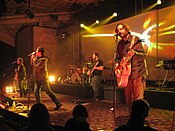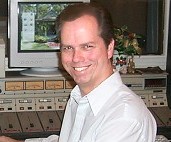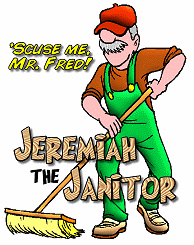Styles
On this radio station you will find the following music styles;
Christian Rock
Within EWCMI Online Radio we mark Christian rock is the form and styles of rock music that promotes Jesus and is typically performed by self-proclaimed Christian individuals and bands whose members focus the lyrics on matters of Christian faith.
The extent to which their lyrics are explicitly Christian varies between bands.
History
Christian response to early rock music (1950s–1960s)
Rock music was not viewed favorably by most traditional and older Christians when it became popular with young people from the 1950s, although early rock music was often influenced by country and gospel music.
Religious people in many regions of the United States did not want their children exposed to music with unruly, impassioned vocals, loud guitar riffs and jarring, hypnotic rhythms. Rock and roll differed from the norm, and thus it was seen as a threat.[1] Often the music was overtly sexual in nature, as in the case of Elvis Presley, who became controversial and massively popular partly for his suggestive stage antics and dancing.
However, Elvis was a religious person who even released a gospel album: Peace in the Valley.[2]
In the 1960s, rock music developed artistically, attained worldwide popularity and became associated with the radical counterculture, firmly alienating many Christians. In 1966 The Beatles, regarded as one of the most popular and influential rock bands of their era, ran into trouble with many of their American fans when John Lennon jokingly offered his opinion that Christianity was dying and that the Beatles were "more popular than Jesus now".[3][4]
The romantic, melodic rock songs of the band's early career had formerly been viewed as relatively inoffensive, but after the remark, churches nationwide organized Beatles record burnings and Lennon was forced to apologize.[5] Subsequently, the Beatles and most rock musicians experimented with a more complex, psychedelic style of music, that frequently used anti-establishment, drug related, or sexual lyrics, while The Rolling Stones sang "Sympathy for the Devil", a song openly written from the point of view of Satan.
This further increased the Christian opposition to rock music.
Countless new bands sprang up in the mid-to-late 1960s, as rock displaced older, smoother pop styles to become the dominant form of pop music, a position it would enjoy almost continuously until the end of the 20th century, when hip-hop finally eclipsed it in sales.
Roots (late 1960s–1980s)
Among the first bands that played Christian rock was The Crusaders, a Southern Californian garage rock band, whose November 1966 Tower Records album Make a Joyful Noise with Drums and Guitars is considered one of the first gospel rock releases,[6] or even "the first record of Christian rock",[7] and Mind Garage, "arguably the first band of its kind",[8] whose 1967 Electric Liturgy was recorded in 1969 at RCA's "Nashville Sound" studio.[9]
Larry Norman, often described as the "father of Christian rock music",[10] and in his later years "the Grandfather of Christian rock",[11] who, in 1969 recorded and released Upon This Rock, "the first commercially released Jesus rock album",[12] challenged a view held by some conservative Christians (predominantly fundamentalists) that rock music was anti-Christian. One of his songs, "Why Should the Devil Have All the Good Music?" summarized his attitude and his quest to pioneer Christian rock music.[13]
A cover version of Larry Norman's Rapture-themed "I Wish We'd All Been Ready" appears in the Evangelical Christian feature film A Thief in the Night and appeared on Cliff Richard's Christian album Small Corners along with "Why Should the Devil Have All the Good Music?".
Another Christian rock pioneer, Randy Stonehill, released his first album in 1971, the Larry Norman-produced Born Twice.[14][15] In the most common pressing of the album, side one is entirely a live performance.[16]
Christian rock was often viewed as a marginal part of the nascent Contemporary Christian Music (CCM) and contemporary gospel industry in the 1970s and '80s,[19] though Christian folk rock artists like Bruce Cockburn and rock fusion artists like Phil Keaggy had some cross-over success.
Petra and Resurrection Band, two of the bands who brought harder rock into the early CCM community, had their origins in the early to mid-1970s.
They reached their height in popularity in the late eighties alongside other Christian-identifying hard rock acts such as Stryper. The latter had videos played on MTV, one being "To Hell with the Devil", and even saw some airtime on mainstream radio stations with their hit song "Honestly".
Christian rock has proved less successful in the UK and Europe, although such artists as Bryn Haworth have found commercial success by combining blues and mainstream rock music with Christian themes.
1990s–present
The 1990s saw an explosion of Christian rock.
Many of the popular 1990s Christian bands were initially identified as "Christian alternative rock", including Jars of Clay, Audio Adrenaline and the later albums of dc Talk. Outside Anglophone countries, bands like Oficina G3 (Brazil) and The Kry (Quebec, Canada) have achieved moderate success. To date Delirious? has been one of the most successful bands from the UK.
By the late 1990s and early 2000s, the success of Christian-inspired acts like Skillet, Thousand Foot Krutch, Decyfer Down, Underoath, Kutless, Disciple and Relient K saw a shift toward mainstream exposure in the Christian rock scene.
Among popular Christian rock bands of the first decade of the 21st century that exemplified this trend were RED and Fireflight.
There are also some Roman Catholic bands such as Critical Mass. Some Eastern Orthodox Christian rock groups, mostly from Russia and the Soviet Union, started performing in the late 1980s and 1990s. Alisa[20] and Black Coffee[21] are credited as the most prominent examples. The Orthodox Christian lyrics of these bands often overlap with historical and patriotic songs about ancient Rus. Christian rock is on the rise in the Russian music underground in 2000s, and Orgia Pravednikov[22] is one of the most notable happenings.
The musical genre that was once rejected by mainstream Christian churches is now considered by some as one of the most-important recruitment tool of their successor congregations.
According to Terri McLean, author of New Harmonies, old-guard churches (United Methodist is given as an example) of the late 1990s were experiencing a rapid decline in membership and were under threat of disbandment within the next decade, a trend that has been going on since the 1980s.[23] McLean, using numerous quotes from theologians, Christian apologists and professors, goes on to offer contemporary Christian music as the reason for the falling popularity of more traditionalist churches.[24]
The definition of contemporary Christian, as offered by New Harmonies, is of a genre not far removed from traditional hymns; it is simply more accessible. The reality is that while a form of modernized hymns do exist in today's churches and do have an impact on church recruitment, there also exists both within and outside these churches a form of music (Christian rock) that has only one element in common with previous religious genres: its worship of God.
This element, the worship of God, is what was originally removed from or hidden within the lyrics of early, secular rock n' roll.
Santino described one method of changing Christian lyrics as a process that transformed “lyrics that sang of the mystical love of God into lyrics that celebrated the earthly love of woman”.[25]
Howard & Streck offer examples of this, comparing Ray Charles' “This Little Girl of Mine” to “This Little Light of Mine” and “Talking About You” to “Talking About Jesus”. They claim that because of actions such as this, despite the liberal editing of the original hymns, “gospel 'showed rock how to sing'”.[26] Howard & Streck go on to describe how the conflict between music and religion, spearheaded by southern fundamentalists, was originally racially based, but how in the sixties this moved on to a clash over the perceived lifestyle of rock musicians.[27]











 Fred Passmore
Fred Passmore
